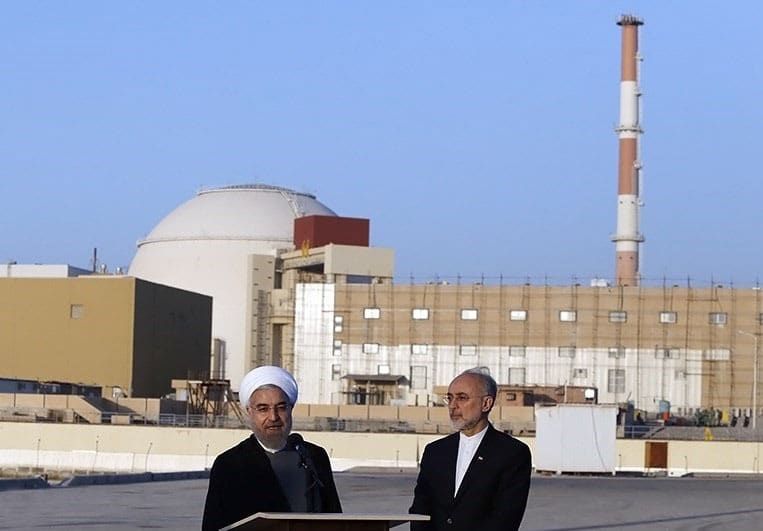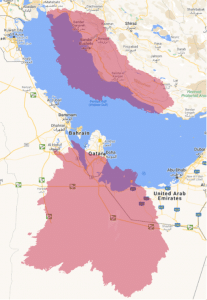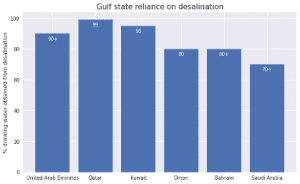How to reduce the risk of a catastrophic spent nuclear fuel fire near the Persian Gulf
By Tara Burchmore, Tom Spence, Ali Ahmad | October 6, 2021
 Iranian President Hassan Rouhani and Head of the Atomic Energy Organization of Iran (AEOI) Ali Akbar Salehi at the Bushehr Nuclear Plant in 2015.
Iranian President Hassan Rouhani and Head of the Atomic Energy Organization of Iran (AEOI) Ali Akbar Salehi at the Bushehr Nuclear Plant in 2015.
The 2021 operational launch of two reactors at the Barakah power plant in Abu Dhabi, United Arab Emirates (UAE) demonstrates the growth of nuclear energy in the Middle East. Over the next two years, there will be five reactors operating in the Persian Gulf—four reactors at Barakah and Iran’s Bushehr reactor, which has been running since 2013. If Iran and Saudi Arabia fulfill their proposed plans to build new nuclear reactors, the number will rise to at least eight reactors in the gulf by 2030.
There are many reasons for concern about the safety of nuclear facilities in the gulf. Particularly in the region where Bushehr is located, Iran is prone to seismic activity. The UAE has limited experience in operating nuclear facilities. And terrorist groups have identified energy infrastructure as a key target—and even attacked nuclear installations.
It is in this context we raise an alarm about the possibility of a severe nuclear accident in the gulf, driven by a fire in one of the spent nuclear fuel pools of the Bushehr or Barakah power plants. As we explain in detail in our recent paper in Science and Global Security, the local and possibly global economic implications of such an accident are huge.
Since the Fukushima Daiichi disaster more than a decade ago and the “near miss” catastrophe of a fire at the unit 4 spent fuel pool, higher attention has been given to the long-overlooked risks of such densely packed pools, which typically have less fortified containment than a reactor core but may contain much larger amounts of radioactivity. Frank von Hippel and his colleagues have since produced important analyses revising the risks of spent nuclear fuel fires and highlighting their human and economic costs.
Cities at risk. In our paper, we modelled what might happen if a spent nuclear fuel fire was to start at either the Barakah or Bushehr nuclear power plants, using an atmospheric modeling program to simulate how the plume of radioactive smoke from the fire would spread over the gulf region based on probable weather patterns.
Based on thousands of dispersion simulations using real historical weather data, the results show that several major cities in the gulf region could be contaminated by cesium 137 fallout if a spent fuel fire occurred at Barakah or Bushehr. The cities at the highest risk from fires at Barakah are those centered around the Gulf of Bahrain: Doha, Manama, Dammam, and al-Hofuf. For each of these cities, there is a greater than five percent chance of being contaminated with more than 1.5 megabecquerels per square meter of cesium 137 (the likely threshold over which the population would need to be evacuated). Of these, Doha presents the biggest risk—in over 10 percent of simulations, evacuation of the city would be required. The cities around Bushehr are at lower risk because that plant would contain less spent fuel than Barakah. The city at the highest risk from spent fuel fires at Bushehr is Ahvaz, which was contaminated with more than 1.5 megabecquerels per square meter of cesium 137 in two percent of the simulations.

Map showing areas in the Persian Gulf with higher than 10 percent probability of receiving above 1.5 megabecquerels per square meter of contamination following a radiation release from a spent nuclear fuel fire in Barakah and Bushehr.
Both cyberattacks and physical attacks on nuclear power plants in the gulf region are real risks. While the Geneva Conventions and International Atomic Energy Agency resolutions have strengthened protections on nuclear sites, the Middle East has seen a number of attacks on such facilities. The 2010 Stuxnet attack on Iran’s nuclear program damaged critical systems, while airstrikes have targeted nuclear installations in Iran, Iraq, and Syria. Another major risk in the gulf region specifically is the presence of violent non-state actors. In 2017, Houthi militants claimed to have launched a cruise missile at the Barakah site while the reactors were under construction. The Nuclear Facilities Attack Database (NuFAD) also shows that Hamas targeted Israel’s Negev Nuclear Research Facility near Dimona in 2014 with a rocket attack that was intercepted by missile defenses.[3]
Magnified vulnerabilities. A nuclear accident in any location is likely to trigger some major public health and economic problems. In the Persian Gulf region, however, these problems will be magnified by three major factors: First, population and economic activity is highly concentrated in cities that are located on the coast and stretch only a few kilometers deep inland, which would complicate relocation efforts. Qatar and Bahrain particularly have limited land to house evacuees—their geography would likely require evacuees from a spent fuel fire to cross international borders.
Second, gulf cities are very dependent on desalinated water. This poses a serious water security threat not only to countries that host nuclear power plants, but to the entire gulf population. The scale of the problem is compounded by the fact that the gulf is a semi-closed, shallow body of water with water circulation estimated to take between two and five years. Some desalination plants can remove cesium from seawater alongside sodium, either through coagulation and sedimentation or reverse osmosis, but in the event of direct fallout, plant operations would be interrupted as workers were evacuated.[4] Gulf cities that rely heavily on water desalination (Doha, Abu Dhabi, Dubai, Manama, Sharjah) only have a few days of storage capacity, so even a temporary shutdown in water production could have severe impacts for them.

Third, gulf countries have a high concentration of economic activities that are either located on the coast or dependent on transport through the gulf. Primary among these activities are oil and gas production and transport. The Persian Gulf’s Strait of Hormuz is the only sea passage from the gulf to the open ocean, making it a major shipping corridor that is potentially vulnerable to contamination from a spent nuclear fuel fire.
Following the 2011 Fukushima disaster, the German government recommended that ships avoid passing within 100 kilometers of the stricken Fukushima reactors, while Japanese authorities advised a 30 kilometer distance and the United States recommended 80 kilometers.[5] As the Strait of Hormuz is 55 kilometers wide at its narrowest point[6] and the gulf is about 340 kilometers at its widest, a recommended avoidance distance of 100 kilometers could be detrimental to shipping, particularly if an accident was to occur at Bushehr. Previous attacks on oil tankers in the region exemplify the vulnerabilities and risks associated with an industry so reliant on a singular narrow sea passage for all export activity and demonstrate how destructive to the global supply chain a nuclear disaster could be.14
A nuclear accident restricting passage through the Strait of Hormuz will likely to result in a global economic shock; a third of world oil is produced in Persian Gulf countries,[7] and 30 percent of all seaborne-traded crude oil passes through the Strait of Hormuz during the export process.[8] If exports are unable to pass through the strait, the oil-dependent world will suffer, particularly Asia, which receives 80 percent of the gulf’s crude exports.[9]
Without the strait, Persian Gulf exports may be unable to be transported, halting most of the economic activity in the region. While some countries, including Saudi Arabia, the UAE, and Iraq, can devise alternate routes for shipping exports, Kuwait, Qatar, and Bahrain are entirely dependent on shipping through the strait.[10] Given their high dependency on oil revenues, an economic shock in the gulf that is driven by a nuclear accident will likely result in an unprecedented level of socioeconomic pressure.
Recommendations. The safest way to mitigate the risk of spent nuclear fuel fires in the Persian Gulf region would be to end the deployment of nuclear energy in the Middle East and rely instead on the region’s natural gas and renewable energy resources. This, of course, will not happen.
However, risks can be reduced by not adding new nuclear capacity beyond what is currently built. Additionally, governments could reduce risks by timely transfer of spent fuel into dry cask storage and ultimately into geological storage, limiting the dense packing of spent fuel pools. Iran has agreed to transfer Bushehr’s spent nuclear fuel to Russia and could seek to do so as soon as it has cooled sufficiently. States also should work to prevent attacks on nuclear facilities. One model could be a multilateral arrangement similar to the bilateral one reached between India and Pakistan. Finally, gulf states should bolster their emergency preparedness and management plans for nuclear accidents and incidents involving potential radiation release in the region.
Notes
[1] Alvarez et al., “Reducing the Hazards from Stored Spent Power-Reactor Fuel in the United States,” 3; “Lessons Learned from the Fukushima Nuclear Accident”, 36; J. Sam Armijo to Allison M. Macfarlane, “Staff Evaluation and Recommendation for Japan Lessons-Learned Tier 3 Issue on Expedited Transfer of Spent Fuel,” December 18, 2013.
[2] MacLean, Trevor, Robert Borrelli, and Michael Haney. “Cyber Security Modeling of Non-Critical Nuclear Power Plant Digital Instrumentation.” In Critical Infrastructure Protection XIII, edited by Jason Staggs and Sujeet Shenoi, 87–100. Cham: Springer International Publishing, 2019.
[3] Reuters, “UAE denies Yemen’s Houthis have fired missile toward UAE,” Reuters, December 3, 2017, https://es.reuters.com/article/us-yemen-security-emirates-denial-idUSKBN1DX0DD; START, Nuclear Facilities Attack Database (NuFAD), 2020, https://www.start.umd.edu/nuclear-facilities-attack- database-nufad.
[4] Sasaki, Takao, Jun Okabe, Masahiro Henmi, Hiromasa Hayashi, and Yutaka Iida. “Cesium (Cs) and Strontium (Sr) Removal as Model Materials in Radioactive Water by Advanced Reverse Osmosis Membrane.” Desalination and Water Treatment 51, no. 7–9 (February 1, 2013): 1672–77. https://doi.org/10.1080/19443994.2012.704696.
Kitada, S., T. Oikawa, S. Watanabe, K. Nagai, Y. Kobayashi, M. Matsuki, K. Tsuchiya, et al. “Removal of Radioactive Iodine and Cesium in Water Purification.” Desalination and Water Treatment 54, no. 13 (June 26, 2015): 3494–3501. https://doi.org/10.1080/19443994.2014.923205.
[5] Kelly, Marie. “Fukushima – Some Implications for the Shipping Industry – International Law – Australia.” Mondaq Norton Rose Fulbright Australia, April 12, 2011. https://www.mondaq.com/australia/international-trade-investment/129262/fukushima–some-implications-for-the-shipping-industry.
[6] “World Oil Transit Chokepoints.” U.S. Energy Information Administration, July 25, 2017. https://www.eia.gov/international/analysis/special-topics/World_Oil_Transit_Chokepoints.
[7] Meredith, Sam. “Here’s Why the Strait of Hormuz Is the World’s Most Important Oil Chokepoint.” CNBC, July 11, 2019. https://www.cnbc.com/2019/07/11/oil-heres-why-the-strait-of-hormuz-is-so-critical-to-energy-markets.html.
[8] “World Oil Transit Chokepoints.” U.S. Energy Information Administration, July 25, 2017. https://www.eia.gov/international/analysis/special-topics/World_Oil_Transit_Chokepoints.
[9] “World Oil Transit Chokepoints.” U.S. Energy Information Administration, July 25, 2017. https://www.eia.gov/international/analysis/special-topics/World_Oil_Transit_Chokepoints.
[10] Ratcliffe, Verity, Julian Lee, and Javier Blas. “Why the Strait of Hormuz Is a Global Oil Flashpoint.” Bloomberg.Com, January 10, 2021. https://www.bloomberg.com/news/articles/2021-01-10/why-the-strait-of-hormuz-is-a-global-oil-flashpoint-quicktake.
Together, we make the world safer.
The Bulletin elevates expert voices above the noise. But as an independent nonprofit organization, our operations depend on the support of readers like you. Help us continue to deliver quality journalism that holds leaders accountable. Your support of our work at any level is important. In return, we promise our coverage will be understandable, influential, vigilant, solution-oriented, and fair-minded. Together we can make a difference.
















